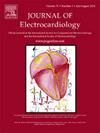小儿镰状细胞病患者QT离散度和T波峰端
IF 1.3
4区 医学
Q3 CARDIAC & CARDIOVASCULAR SYSTEMS
引用次数: 0
摘要
目的应用超声心动图和心电图(ECG)检测镰状细胞病(SCD)和镰状地中海贫血患儿心脏复极变化及心律失常的风险。方法采用观察性病例对照研究,将2022年11月至2023年7月在法云大学附属医院血液科门诊定期随访的20例SCD和20例镰状地中海贫血患者与40例普通门诊无血液科或心脏病史的健康对照进行比较。所有患者均接受临床及常规超声心动图、组织多普勒成像(TDI)和长条心电图检查。结果两组患者QT、QT校正(QTc)和QT离散度(QTd)间期均显著增高(p = 0.001)。镰状病人的t波峰端间隔(Tp-e)明显高于对照组。各病例组的Tei指数和e′波速度均高于对照组,差异有统计学意义(p <;0.05)。QTc、QTd间期与各组肺动脉压(ESPAP)、等容积收缩时间(IVCT)、Tei指数、s波速度均有统计学意义的正相关。结论SCD合并镰状地中海贫血患儿有发生恶性心律失常和心源性猝死的危险。与健康个体相比,他们的QTc、QTd和Tp-e间隔更长。QTc延长与左心室面积增大、肺动脉高压和整体心肌功能障碍显著相关。本文章由计算机程序翻译,如有差异,请以英文原文为准。
QT dispersion and T wave peak-to-end in pediatric patients with sickle cell disease
Aim
The aim of the study was to detect cardiac repolarization changes and the risk of arrhythmias in children with sickle cell disease (SCD) and sickle thalassemia using echocardiography and electrocardiography (ECG).
Methods
This is an observational case-control study that compared 20 patients with SCD and 20 patients with sickle thalassemia who regularly follow in the outpatient hematology clinic of Fayoum University Hospital with 40 healthy controls with history of non-hematological or cardiac illness who attended the general outpatient clinic from November 2022 to July 2023. All patients were evaluated clinically and by routine echocardiography, tissue Doppler imaging (TDI), and long-strip ECG.
Results
The QT, QT corrected (QTc), and QT dispersion (QTd) intervals were significantly higher in the case groups (all p = 0.001). There was a significantly higher T-wave peak-to-end interval (Tp-e) among sickle patients in comparison to controls. There was a statistically significant higher level of Tei index and velocity of the e’ wave among each case group in comparison to the control group (p < 0.05). As regards QTc and QTd intervals, there was a statistically significant positive correlation with each of estimated pulmonary artery pressure (ESPAP), isovolumetric contraction time (IVCT), Tei index, and velocity of the s' wave among study groups.
Conclusions
The risk of malignant arrhythmia and sudden cardiac death may occur in children with SCD and sickle thalassemia. They had longer QTc, QTd, and Tp-e intervals than healthy individuals. Prolonged QTc was significantly associated with increased left ventricular dimensions, pulmonary hypertension, and global myocardial dysfunction.
求助全文
通过发布文献求助,成功后即可免费获取论文全文。
去求助
来源期刊

Journal of electrocardiology
医学-心血管系统
CiteScore
2.70
自引率
7.70%
发文量
152
审稿时长
38 days
期刊介绍:
The Journal of Electrocardiology is devoted exclusively to clinical and experimental studies of the electrical activities of the heart. It seeks to contribute significantly to the accuracy of diagnosis and prognosis and the effective treatment, prevention, or delay of heart disease. Editorial contents include electrocardiography, vectorcardiography, arrhythmias, membrane action potential, cardiac pacing, monitoring defibrillation, instrumentation, drug effects, and computer applications.
 求助内容:
求助内容: 应助结果提醒方式:
应助结果提醒方式:


